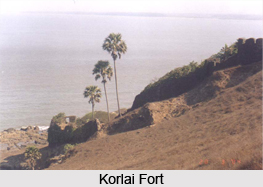 History of Korlai fort narrates the various events that led to the changing possession of the fort over years. Korlai fort stands in the Korlai town of Maharashtra and was constructed by Portuguese in 1521. The fortification was built on an island guarding the way to the Revdanda Creek. It was structured by the Portuguese after they received permission from the Ahmednagar Sultanate. In 1521, the region encountered a temporary chaos after the death of Burhan Nizam and the Portuguese tried to capture the fort. But owing to the retaliation of Sultan the fort was reclaimed by the latter with the aid of his best soldiers. Subsequently an agreement was made between the tow parties according to which the Ahmednagar Sultanate took possession of the island and prohibited further fortification of the island. As signature of the former rulers, only a wooden cross was left on the island.
History of Korlai fort narrates the various events that led to the changing possession of the fort over years. Korlai fort stands in the Korlai town of Maharashtra and was constructed by Portuguese in 1521. The fortification was built on an island guarding the way to the Revdanda Creek. It was structured by the Portuguese after they received permission from the Ahmednagar Sultanate. In 1521, the region encountered a temporary chaos after the death of Burhan Nizam and the Portuguese tried to capture the fort. But owing to the retaliation of Sultan the fort was reclaimed by the latter with the aid of his best soldiers. Subsequently an agreement was made between the tow parties according to which the Ahmednagar Sultanate took possession of the island and prohibited further fortification of the island. As signature of the former rulers, only a wooden cross was left on the island.
Later in the year 1594 a Portuguese captain named Abranches captured the fort along with 1,500 soldiers and 1,500 natives. The soldiers of the Sultanate however tried to defend by blocking their way. They blocked their path by putting a dead horse at the inner gate and a dead elephant at the main gate. In spite of all the efforts they had to surrender. Although the Portuguese managed to win the fort they did not have many soldiers to guard it. Consequently they chose to destroy the fort only leaving behind a battery and the central tower intact.
Before the fort was demolished, the travellers had described the fort as a splendid one which was amongst the strongest forts of the world. It was susceptible to attack only on the inland side but was protected there by a ditch which could be assessed only by a drawbridge. A bronze lion guarded the main entrance of the fort and a bronze eagle guarded the highest tower. A large number of men and 7000 horses were sheltered by the fort. Certain parts of the fort were reconstructed at a later period, after its destruction, but then it housed a garrison of only 50 men. There was a church inside the fort where worship was held on Sundays and holidays. The strategic location of Korlai fort guarded the mouth of the bay and was immensely significant. Once an attempt was made by Sambhaji, who was the son of Shivaji, to capture the fort but he failed in his endeavour and withdrew his forces on 6th December 1687. Later it was taken over by the Marathas who possessed it from 1739 to 1818.



















